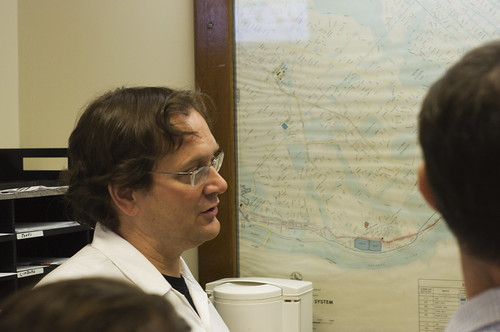DC Water’s George Hawkins is an interesting man. He took over the District’s water and sewer authority last year, with no previous experience managing a utility. Previously he had worked for the District’s Department of the Environment, and before that spent some time with the EPA. He’s an idea guy, and that’s what came across last night at a blogger roundtable at DC Water’s Bryant Street Pumping Station.
Hawkins has bet his career on transforming the city’s water agency, which has been plagued with bad public relations for nearly a decade. Earlier this month, the agency unveiled their new trade name and slogan, DC Water: Water is Life. The agency’s new logo was created from contest entries.
For nearly two hours, Hawkins discussed the challenges of running the city’s water infrastructure. The system is aging, with some significant parts dating back to the Civil War. Nearly 20% of the system is over 100 years old. It’s the story of infrastructure everywhere in the 21st century. Rate increases are needed, as well as more capital funding for quicker upgrades.

Photo by the author
The question on everyone’s mind, of course, was about lead in the water. For anyone who lived here in 2003-2005 or so, DC Water will be associated with cover-ups and Britta filters. Hawkins is not afraid to talk about this, the incidents occurred long before his tenure. He makes it a point to explain that the problem originated with the city’s water supplier. An explanation, of course, but little more than that. He assures residents that the agency is dedicated to improving transparency, and making sure customers know immediately of any health risks. The right track, of course, but there’s a long road to go to restoring trust.
Hawkins and his team are on track to make improvements, both with the water infrastructure and how they communicate with the public. His vision is for a water agency that is more than just a utility, but a force for all sorts of quality of life improvements. At this point, though, it’s safe to say most residents would be happy with an agency that can deliver clean, safe water efficiently.

Pingback: Where the water comes from « City Block